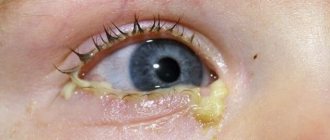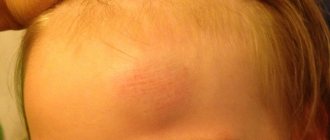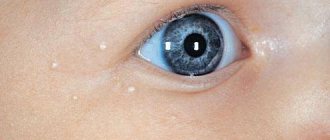A newborn’s eye is festering - what to do and what not to do
The baby's body is protected by maternal antibodies for up to 6 months, but this does not mean that infants do not get sick. One of the common problems that a young mother has to deal with is a festering eye in a newborn.
Why the disease occurs, what medicines and folk remedies can be used - we will talk about all this with you today.
A baby's eye is festering - reasons
Every mother, even before the birth of her child, carefully studies all the rules for caring for her baby, but even if all hygiene standards are observed, the baby’s eye often sours.
Purulent processes in the eyes can occur in a baby immediately after birth if viruses and bacteria were present in the birth canal.
Why does a baby's eye fester?
- Dacryocystitis is a blockage of the nasolacrimal duct, a problem that occurs in approximately 40-60% of newborns. Most tears flow down ducts into the nasal cavity, but during fetal development these ducts are closed with a thin film. Immediately after birth, with the first cry, it should rupture, but if this does not happen, stagnation occurs, pathogenic microorganisms multiply in the tear fluid, and a purulent plaque forms.
- Viral conjunctivitis occurs rarely in children, most often as a complication of ARVI, or when infected with a herpes infection from the mother. The discharge is light, without a strong odor, there is no itching or swelling of the eyes, and the lymph nodes may become enlarged. With a herpes infection, dots appear on the mucous membrane or a rash around the eye.
- Bacterial conjunctivitis - occurs when infected with staphylococci, gonococci, pneumococci, diphtheria bacillus. The discharge is abundant, yellow-green or grayish in color, often has an unpleasant odor, eyelashes stick together after sleep, there is severe swelling and redness of the mucous membranes, photophobia, profuse lacrimation, and fever.
- Allergic conjunctivitis. Due to severe itching, the baby constantly pulls his hands to his face, his eyes water, swell and turn red, the discharge is viscous, mucous, and light.
- Redness of the eye can be caused by eyelashes, or optic nerve atrophy.
A newborn’s eye is festering - what to do?
The choice of treatment method depends on the cause that caused the appearance of pus in the eyes, so the first thing you need to do is visit a pediatric ophthalmologist.
Pus in the eyes of a child - how to treat:
- antihistamines – Allergodil, Kromofarm;
- antibiotics – Furacilin, Albucid 10%, Sulfacyl sodium, Levomycetin 0.25%, Tobrex;
- antiviral agents – Zovirax ointment;
- antiseptics - Collargol, Vitabakt, Miramistin.
Oftalmoferon drops are considered one of the best - the medicine has an antiviral, antihistamine effect, eliminates pain, and accelerates the process of regeneration of damaged tissues.
Even if the inflammatory process is observed in one eye, both eyes need to be treated at the same time. When using antibiotics, the duration of therapy is 5-7 days; do not stop treatment ahead of time, even if the manifestations of the disease have completely disappeared.
For dacryocystitis, rinsing and instillation will not help; the doctor will prescribe massage or physiotherapy; in severe cases, probing of the tubules is performed - this is a simple surgical intervention, absolutely harmless to the child.
How to wash a child’s eyes - folk remedies
Alternative medicine methods are considered the safest, but when treating infants, use them with caution, and only after consulting a doctor, since even harmless remedies can cause severe allergies and other negative reactions in the baby.
Simple solutions for compresses and rinsing:
- Strong black, or better green tea - use natural high-quality raw materials without dyes or flavors.
- Chamomile infusion is a good anti-inflammatory agent. Brew 250 ml of boiling water 8 tsp. chopped inflorescences, leave in a sealed container for an hour, strain well. Carry out the procedure several times a day, keep the compresses for 5-7 minutes.
- Calendula decoction effectively fights purulent inflammatory processes. Brew 1 tbsp. l. raw materials 270 ml of boiling water, simmer over low heat for 10 minutes, cool, strain. Use the solution as a compress or rinse after each sleep.
The baby's eye is festering - what not to do
Never put breast milk or water with honey in the eyes of a newborn - pathogenic microbes multiply quickly in these liquids.
Do not heat inflamed areas if the problem is caused by bacteria.
You cannot remove pus in a child’s eyes with solutions based on alcohol and oils, peroxide, hormonal and vasoconstrictor drugs, or products containing Ciprofloxacin.
Prevention methods
It is impossible to avoid the development of dacryocystitis, since you cannot influence the rupture of the protective film in any way. But massage and regular eye washing will help avoid serious complications.
But you are quite capable of preventing the development of viral and bacterial infections:
- every day, carry out hygiene procedures 2-3 times, in the first month it is better to rinse your eyes with saline solution or a weak solution of Furacilin, then you can use ordinary boiled water;
- do not touch the baby’s face with dirty hands;
- If you have a cold, be sure to wear a gauze bandage before feeding and interacting with your baby.
The best way to avoid infectious pathologies is to strengthen the immune system early and regularly.
Don’t bundle up your baby, take more walks, eat healthy and balanced while breastfeeding, choose complementary feeding products based on the baby’s age.
Air and sun baths, daily gymnastics are beneficial for babies; be sure to maintain the temperature in the room within 18-22 degrees, humidity - 50-70%.
Conclusion
Source: https://its-kids.ru/u-novorozhdennogo-gnoitsya-glaz.html
How to care for newborn eyes
Every morning, the mother should carefully examine and evaluate the condition of the baby’s eyes - if they are healthy, then the baby just needs to be washed. The most convenient way to do this is on a changing table. Mom needs to prepare in advance a container of boiled water at room temperature, cotton pads and gauze wipes.
The basic rule for washing a baby is the direction of movement. When washing a child's eyes, wipe them exclusively from the outer corner of the eye to the inner corner; they should never be washed in the opposite direction.
This is due to the fact that if there is an infection in the baby’s eye, all of it accumulates in the inner corner. If you wash your baby incorrectly, then accumulations of bacteria are spread throughout the eye, thereby aggravating the inflammatory process.
You should use a separate cotton pad for each eye. If you do not follow this rule, you risk infecting one eye from the other.
To wash your baby you need:
- soak a cotton pad in boiled water.
- squeeze it out lightly.
- wipe the eye and blot with a gauze napkin.
Then carry out the same actions with the second one. All movements of the mother should be neat and delicate, under no circumstances should you put pressure on the eyes!
For regular washing of a healthy baby, it is not recommended to use herbal decoctions, solutions of antibacterial drugs, cosmetic wipes, or tea leaves. If you notice souring, inflammation, redness of the eyes, do not self-medicate!
Permitted and prohibited drops during breastfeeding: what mothers should know
Eye diseases require immediate treatment, usually local. And lactation makes you wary of taking any medications. After all, some of them can pass through milk to the baby. Therefore, eye drops should be used with caution when breastfeeding. Among them there are some that should not be used at all during this period.
Common eye drops: do's and don'ts
It is necessary to get rid of an eye disease like any other. An infection that has captured the visual organ is caused by microorganisms that migrate easily. That is, the disease can spread and become even more threatening and global. Then it can be passed on to the child.
The instructions for many eye drops contain information about the undesirability of use during lactation, for some there is a direct ban on it. In some cases it is recommended to use with caution.
But nursing mothers are still worried that eye drops during lactation will harm the baby, even when the doctor prescribes them. In order not to worry in vain, it is worth knowing about the entire range of such drugs.
Others
The therapy of eye diseases is not limited to the listed drugs. There are products that can be used safely during lactation:
- "Ophthalmoferon" is used in the treatment of various origins of conjunctivitis, keratitis, as well as dry eye syndrome. It is also indicated for swelling of the mucous membrane caused by allergies, to prevent relapses of these diseases. "Ophthalmoferon" cannot be compared in effectiveness with antibiotics. But it can be used during lactation without the risk of harming the baby. Despite the presence of diphenhydramine, it is safe. After all, Oftalmoferon does not pass into breast milk. Of course, do not forget about the correct dosage of the product.
- "Aktipol" is an antiviral drug for the eyes that stimulates the production of its own immune cells. It relieves swelling well and eliminates conjunctivitis, restores damaged cornea. The active ingredient of the drug does not penetrate into the blood or breast milk. Therefore, when asked what kind of eye drops can be used during lactation, they call “Actipol”.
- "Vitabact" has broad capabilities to combat bacteria leading to conjunctivitis, keratitis, and trachoma. One of its features is the lack of influence on the composition of breast milk. Therefore, Vitabact can be used during lactation without fear for the child.
Watch the video on how to properly instill eye drops:
Baby's eyes turn sour
Even the youngest and most inexperienced parent can easily recognize such a problem as souring or suppuration of the eyes. First, you will notice that the child is constantly scratching his eyes. Then you will notice watery eyes, redness of the eyelids, and it will be difficult for the baby to open his eyes due to the stuck together eyelashes. All this is often accompanied by an increase in temperature, as a result of which your little one is capricious, refuses to eat, and sleeps poorly. How to wash a newborn’s eyes if they fester? The first step is to determine the cause of this manifestation. Perhaps it:
Acidity of the eyes due to conjunctivitis
- Physiological reason;
- Infection;
- Allergy;
- Dacryocystitis;
- Conjunctivitis.
Usually getting rid of this unpleasant disease is not difficult. You just need to contact your pediatrician in a timely manner to find out the cause, and the specialist will definitely tell you how to wipe the newborn’s eyes if they fester.
If the reason is physiological, then a chamomile decoction will help, which pediatricians recommend not only for wiping the eyes, but also for bathing the baby. In order to prepare a medicinal infusion, you need to combine 1.5 cups of boiling water with 1 tbsp. dried and crushed flowers, cover and leave for 15 - 20 minutes.
Dacryocystitis in an infant
When, when washing your baby, you notice that when you lightly press on the inner corner of the eye, pus is released, you need to urgently go to the doctor. Basically, dacryocystitis is treated at home with massage, which the doctor will definitely teach you how to do, and rinsing with a solution of furatsilin or potassium permanganate.
With dacryocystitis, the nasolacrimal passage is blocked, and if the child’s condition does not improve within two months, the lacrimal canals are washed quickly and painlessly in the hospital.
How to wash a child’s eyes if they fester?
If purulent contents are separated from the eye, they stick together in the morning after a night's sleep, the temperature rises, and the eyeball becomes very red, this means that the child is developing an inflammatory process.
This clinical picture can be observed when:
- Chalazion of the upper or lower eyelid.
- Hordeolume (barley).
- Dacryocystitis.
In this case you need to use:
- Antiseptic Furacilin or Potassium Permanganate (potassium permanganate). It is not allowed to use highly concentrated rinsing solutions.
- A weak salt solution of Sodium Chloride has a good effect.
- Miramistin.
- As for herbal remedies, it is allowed to use infusions of chamomile or calendula flowers.
Washing the child’s eyes is only part of the therapy, since when purulent discharge appears, eye drops and ointments with an antibacterial effect are simultaneously prescribed:
- Tobrex.
- Phloxal.
- Tetracycline ointment.
How and what to wipe the eyes of a newborn with conjunctivitis?
Before wiping a newborn baby's eyes, make sure that the discomfort is not caused by a life-threatening disease.
Conjunctivitis is an inflammation of the mucous membrane of the eye that is caused by an allergy, infection or virus. Typically, suppuration goes away within 3–4 days after visiting a pediatrician, who will prescribe the necessary course of treatment and explain how and with what to wash the eyes of newborns.
These may be special children's drops with antibiotics, or the doctor will recommend a solution of potassium permanganate or furatsilin. You can also wash your eyes with chamomile infusion.










